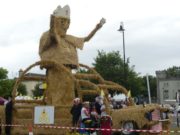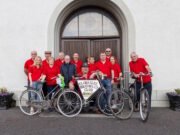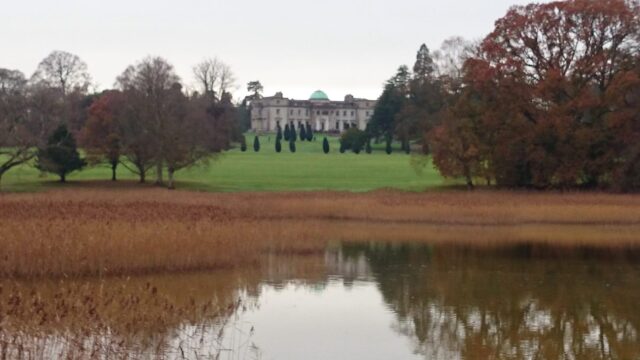This piece originally appeared on LaoisToday last September to make the 25th anniversary of Emo Court coming into state ownership.
It’s arguably the most popular public attraction in Laois and last week was the 25th anniversary of Emo Court coming into state ownership.
On September 27 1995, Emo Court was handed over to the state by its then owner Cholmeley Harrison. President Mary Robinson was on hand to accept it a ceremony on the grounds. Michael D Higgins – then the Minister for Arts, Culture and the Gaeltacht – was due to attend also, though had to withdraw at late notice.
Prior to that, the deal to bring the estate under the care of the Office of Public Works was negotiated by a certain Phil Hogan, then the Minister for State with responsibility for the OPW.
The house and its 250 acres, including agricultural land, gardens, woodland and lake was handed over to the state on a part donation, part sale basis.
“It is our intention to complete the restoration work on the house and gardens and have it open for as much access to the public as possible,” an OPW spokesperson said in mid January 1995 when John Whelan broke the story on the front page of the Leinster Express.
And the story got significant coverage when the official duties took place in the autumn of that year.
“It was a simple ceremony, over in seconds,” wrote John Whelan, in the first line on his report of the occasion.
“But the speed with which the key to Emo Court was symbolically handed over to President Mary Robinson on behalf of the state belied its significance.
“The unique and impressive Gandon-designed ediface and its idyllic gardens were formally accepted on behalf of the people of Ireland by the President and the property represents a major acquisition by the Office of Public Works (OPW) and a significant addition to its heritage portfolio.”
Cholmeley Harrison had bought Emo Court in 1969 from the Jesuit Order for £42,000, who had owned it since 1929. It was a base for their novice priests.
Born in Kent in England in 1908, Harrison was educated in Cambridge and went on to become a member of the London Stock Exchange in 1938 where he earned his living right up until the 1970s. He also served as a Major in the Royal Marines during World War 2.
In 1931, Cholmeley-Harrison married Barbara Mary Corisande, a daughter of Lord Bellew of Meath. The couple had three daughters, but were divorced in 1948. At the end of the war, in 1945, he moved to Ireland, acquiring Woodstown House in Waterford which was a Regency villa overlooking Waterford Harbour.
In the summer of 1967, Cholmeley-Harrison rented Woodstown to Mrs Jacqueline Kennedy, widow of US President John F Kennedy, and her family. However, such was the intrusion to his privacy as a result, he decided to sell the house and he acquired Emo Court.
The house, though, needed plenty of attention but Cholmeley-Harrison dedicated years to the project – and at considerable cost – under the guidance of Sir Albert Richardson and Partners of London.
According to the architectural historian Mark Bench-Jones, he “restored and redecorated the house most sympathetically” and “furnished it with great taste and splendour”.
Emo Court was designed by the great Georgian architect James Gandon and was built in the “monumental style” of the Custom House in Dublin, beginning in 1790, for the first Earl of Portarlington who was instrumental in bringing Gandon to Ireland.
The Earl died before it was finished, the second Earl had no money and so it was left to the third Earl to complete the job.
According to Bench-Jones, “Emo Court only came into its own post 1969” when Cholmeley-Harrison acquired it and completed some of the work originally planned by Gandon. And when he finished the house, he turned his attention to the gardens.
He was well-respected in the Emo area and provided much employment on the grounds though the Irish Times obituary on his death noted that “he was meticulous and very strict as to how the work should be carried out”.
Initially the public were able to pay a fee to visit the gardens on a Sunday but in 1994, he took the decision to hand over the property to the state. Tours of the house then became popular while various walking routes – including a very scenic one around the lake – were developed and are hugely popular.
Cholmeley-Harrison continued to live in an apartment on the site up until his death, just shy of his 100th birthday in 2008. He regularly attended the nearby church at Coolbanagher where he was also generous with his gifts.
“The future of Emo, he felt, would be secure only if it was in State ownership and though the OPW, for lack of funds, was initially reluctant to take it over, he persisted and in 1994 he handed the house and grounds to the State, with the proviso that he could remain in an apartment there for the rest of his life,” added the Irish Times.
On the day of the handing over ceremony, then aged 87, his speech was short and sweet.
“I give to you, and through you to the people of Ireland, Emo Court, its contents and gardens, which is all I have to say,” was his quick few words.
According to John Whelan’s report of the event, President Robinson “enthusiastically applauded Mr Cholmeley-Harrison for his generosity” and “was confident that Emo Court would represent the start of a regeneration for the entire area”.
“She said that its acquisition by the OPW fitted into a broader strategy which was now fully appreciating the significance and importance of such heritage sites as Heywood, Birr, Roscrea and Kilkenny.
“She spoke of the extraordinary and compelling power of such a property which had the capacity to greatly enhance the lives of all those in the community.
“It was not until recently, the President said, that we have come to fully appreciate the significance of such heritage monuments as Emo Court which had an important role to play in today’s society as they draw in visitors, created employment and regenerated the community.”
“I can assure Mr Cholmeley-Harrison that Emo Court is in very safe hands with the Office of Public Works,” she said.
“I myself look forward to getting back here and rambling around and enjoying the house and gardens which are now a resource for the people of Ireland. We are most grateful for your dedication and generosity.”
Among those in attendance on that September day were students from Emo and Killenard National Schools and guests from the community and invited dignatories.
“The Earl of Rosse from Birr, Desmond Fitzgerald, the Knight of Glin and the Georgian Society and Mr Cholmeley-Harrison’s daughters – Caroline, the Countess of Inchape, and Charlotte Marsh – were also in attendance.”
SEE ALSO – Weekend Read: Laois and midlands crying out for camping facilities




















